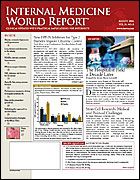Publication
Article
Prescribe Intensive Statin Therapy for Patients With chd Plus Metabolic Syndrome
Author(s):
WASHINGTON, DC—New findings reported at the 66th Scientific Sessions of the American Diabetes Association indicate that high-dose atorvastatin (Lipitor) significantly reduces cardiovascular (CV) risk in patients with concomitant coronary heart disease (CHD) and metabolic syndrome.
Prakash Deedwania, MD, chief, Cardiology Division, University of California, San Francisco Medical School, Fresno, and colleagues examined the effect of atorvastatin on the components of the metabolic syndrome in 5584 patients with CHD. Patients were randomized to atorvastatin 10 mg/day (n = 2820) or 80 mg/day (n = 2764).
At 5 years of follow-up, patients with CHD and concomitant metabolic syndrome had a 44% greater risk of major CV events than those without the metabolic syndrome.
“Our data provide justification for more intensive lipid-lowering therapy in these patients,” Dr Deedwania said. “In fact, reducing low-density lipoprotein cholesterol [LDL-C] levels to <70 mg/dL may be particularly warranted.”
The metabolic syndrome is closely linked to the development of diabetes and CHD. The Third Report of the National Cholesterol Education Panel (NCEP) recognized (in 2001) the importance of treating metabolic risk factors as a secondary target of CV risk reduction, with LDL-C being the primary target.
In 2004, the NCEP’s Adult Treatment Panel affirmed its LDL-C goal of <100 mg/dL in patients with CHD or risk equivalents and added an optional goal of <70 mg/dL for those at very high risk (eg, those with established CHD plus other high-risk conditions, including the metabolic syndrome).
More recently, on the basis of the TNT (Treating to New Targets) and IDEAL (Incremental Decrease in Endpoints Through Aggressive Lipid Lowering) trials, the American Heart Association, American College of Cardiology, and National Heart, Lung, and Blood Institute recommended adapting the LDL-C goal of <100 mg/dL in CHD patients and suggested that further reduction to <70 mg/dL was a reasonable goal.
Patients were included in this study if they met ≥3 of the following metabolic syndrome criteria: body mass index ≥28 kg/m2; triglycerides ≥150 mg/dL; high-density lipoprotein cholesterol <40 mg/dL; blood pressure ≥130/85 mm Hg; and fasting glucose ≥100 mg/dL.
P
After a median follow-up of 4.9 years, 11.3% (629) of the patients with concomitant metabolic syndrome had a major CV event, regardless of treatment assignment, compared with 8% (353) of those without the metabolic syndrome ( <.001).
A major CV event was defined as death from CHD; nonfatal, nonprocedure-related myocardial infarction; resuscitated cardiac arrest; or fatal or nonfatal stroke.
Patients with concomitant CHD and the metabolic syndrome who also had diabetes were at greatest risk. However, when those with diabetes were excluded from the analysis, patients with CHD and the metabolic syndrome still had a 35% greater risk of a CV event than patients without the metabolic syndrome.
An incremental increase in risk was associated with each additional feature of the metabolic syndrome, Dr Deedwania noted. Thus, despite similar relative risk reductions with atorvastatin 80 mg, the absolute benefit was greater in those with the metabolic syndrome because of their higher absolute risk. Overall, the absolute risk reduction with higher atorvastatin dose (80 mg/d) for those with zero to 2 metabolic syndrome components was 0.6% and for patients with 5 components, 5.2%.
“Our results support the classification of patients with CHD and metabolic syndrome as very high risk, irrespective of the presence of diabetes, and additionally suggest that these patients may benefit from a more intensive lipid-lowering strategy,” Dr Deedwania said.
KEY POINTS
Concomitant metabolic syndrome and CHD increased patients’ risk for a major CV event by 44%.
An incremental increase in risk was associated with each additional feature of the metabolic syndrome.
High-dose atorvastatin therapy (80 mg/d) reduced CV risk in patients with CHD and metabolic syndrome by up to 5.2%.
Reducing LDL-C to <70 mg/dL may be particularly important in these patients.






